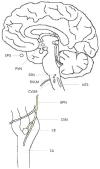Cluster Headache and Hypoxia: Breathing New Life into an Old Theory, with Novel Implications
- PMID: 39728749
- PMCID: PMC11679651
- DOI: 10.3390/neurolint16060123
Cluster Headache and Hypoxia: Breathing New Life into an Old Theory, with Novel Implications
Abstract
Cluster headache is a severe, poorly understood disorder for which there are as yet virtually no rationally derived treatments. Here, Lee Kudrow's 1983 theory, that cluster headache is an overly zealous response to hypoxia, is updated according to current understandings of hypoxia detection, signaling, and sensitization. It is shown that the distinctive clinical characteristics of cluster headache (circadian timing of attacks and circannual patterning of bouts, autonomic symptoms, and agitation), risk factors (cigarette smoking; male gender), triggers (alcohol; nitroglycerin), genetic findings (GWAS studies), anatomical substrate (paraventricular nucleus of the hypothalamus, solitary tract nucleus/NTS, and trigeminal nucleus caudalis), neurochemical features (elevated levels of galectin-3, nitric oxide, tyramine, and tryptamine), and responsiveness to treatments (verapamil, lithium, melatonin, prednisone, oxygen, and histamine desensitization) can all be understood in terms of hypoxic signaling. Novel treatment directions are hypothesized, including repurposing pharmacological antagonists of hypoxic signaling molecules (HIF-2; P2X3) for cluster headache, breath training, physical exercise, high-dose thiamine, carnosine, and the flavonoid kaempferol. The limits of current knowledge are described, and a program of basic and translational research is proposed.
Keywords: cluster headache; genes; hypoxia inducible factor; neurochemistry; pharmacology; prevention; trigeminovascular.
Conflict of interest statement
The author has no competing interests to declare that are relevant to the content of this article.
Figures



Similar articles
-
Cluster Headache: What's New?Neurol India. 2021 Mar-Apr;69(Supplement):S124-S134. doi: 10.4103/0028-3886.315983. Neurol India. 2021. PMID: 34003158 Review.
-
Cluster Headache: Epidemiology, Pathophysiology, Clinical Features, and Diagnosis.Ann Indian Acad Neurol. 2018 Apr;21(Suppl 1):S3-S8. doi: 10.4103/aian.AIAN_349_17. Ann Indian Acad Neurol. 2018. PMID: 29720812 Free PMC article. Review.
-
The first-line cluster headache medication verapamil alters the circadian period and elicits sex-specific sleep changes in mice.Chronobiol Int. 2021 Jun;38(6):839-850. doi: 10.1080/07420528.2021.1892127. Epub 2021 Apr 8. Chronobiol Int. 2021. PMID: 33829951
-
Regulation of headache response and transcriptomic network by the trigeminal ganglion clock.Headache. 2024 Feb;64(2):195-210. doi: 10.1111/head.14670. Epub 2024 Jan 30. Headache. 2024. PMID: 38288634 Free PMC article.
-
Cluster headache.Orphanet J Rare Dis. 2008 Jul 23;3:20. doi: 10.1186/1750-1172-3-20. Orphanet J Rare Dis. 2008. PMID: 18651939 Free PMC article. Review.
References
Publication types
LinkOut - more resources
Full Text Sources

